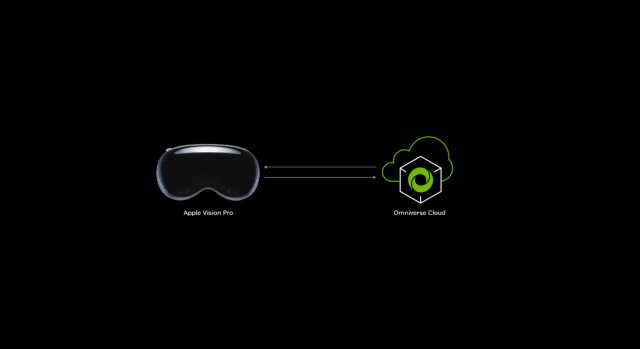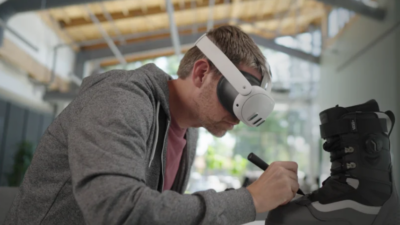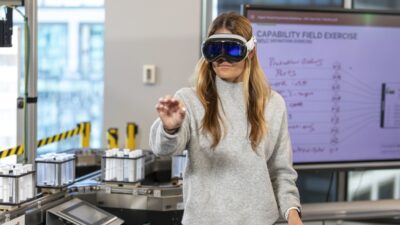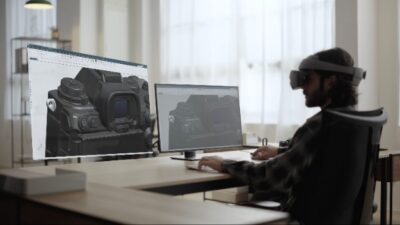Announced at Nvidia GTC 2024, new Omniverse Cloud APIs will bring the digital twin platform to even more engineers.
There’s no shortage of exciting news from coming this week from Nvidia GTC, the company’s first live event in five years. The big hardware news was Nvidia Blackwell, the successor to Nvidia’s Hopper GPU architecture that CEO Jensen Huang heralded as the processor for the AI era.
But there was plenty of software news as well, and the updates to Nvidia Omniverse signal exciting new opportunities for the 3D simulation, visualization and collaboration platform. Omniverse continues to expand with a new set of Cloud APIs enabling new partners and integrations—including the Apple Vision Pro.
Omniverse comes to the Apple Vision Pro
Apple’s recently released virtual and augmented reality (VR/AR) headset, the Apple Vision Pro, has sparked a new wave of consumer interest in spatial computing. Professional users are also keenly watching the new headset, and Nvidia has given them another reason to be excited for its potential as a design tool: Nvidia Omniverse data and applications can now be streamed to the Apple Vision Pro.

The Vision Pro connection is built on five new Omniverse Cloud APIs for interacting with Universal Scene Description (OpenUSD) data, the foundation of Nvidia Omniverse. The new APIs include USD Render, which generates ray-traced renders of OpenUSD data; USD Write, which allows users to modify OpenUSD data; USD Query, which enables scene queries and interaction; USD Notify, which keeps track of changes to OpenUSD data; and Omniverse Channel, which provides a connection for collaboration across users and tools.
There’s another step to bring Omniverse to the Apple Vision Pro. The new Omniverse Cloud APIs send the OpenUSD data to Nvidia’s Graphics Delivery Network (GDN), which Nvidia’s press release describes as “a global network of graphics-ready data centers that can stream advanced 3D experiences to Apple Vision Pro.”
The GDN is an important part of the equation. As a standalone headset, the Apple Vision Pro can’t offer the graphics horsepower needed to render Omniverse data with the full ray-traced realism that users expect, particularly for applications such as design reviews or product configuration. Streaming that OpenUSD data over GDN, Nvidia claims, allows the Vision Pro to provide fully detailed, photorealistic 3D graphics.
“Apple Vision Pro is the first untethered device which allows for enterprise customers to realize their work without compromise,” said Rev Lebaredian, vice president of simulation at Nvidia, in the press release.

“The breakthrough ultra-high-resolution displays of Apple Vision Pro, combined with photorealistic rendering of OpenUSD content streamed from Nvidia accelerated computing, unlocks an incredible opportunity for the advancement of immersive experiences,” Mike Rockwell, vice president of the Vision Products Group at Apple, said in the release.
Omniverse in Teamcenter and beyond
For engineers who don’t yet have an Apple Vision Pro, there a few more familiar tools that are embracing Nvidia Omniverse’s new Cloud APIs. Huang announced in his March 18 keynote that Siemens will be using the new APIs across its Xcelerator portfolio of engineering software, starting with its cloud-based PLM tool Teamcenter X.
“Through the Nvidia Omniverse API, Siemens empowers customers with generative AI to make their physics-based digital twins even more immersive,” said Siemens CEO Roland Busch in an Nvidia press release announcing the new APIs. “This will help everybody to design, build and test next-generation products, manufacturing processes and factories virtually before they are built in the physical world.”

Siemens isn’t the only software provider implementing the new APIs to connect Omniverse to their applications. Nvidia announced several other partners that will be adopting the Omniverse Cloud APIs, including Ansys, Cadence, Dassault Systèmes (for its 3DExcite brand), Hexagon, Microsoft, Rockwell Automation and Trimble.
Huang sees digital twins as one of the core applications of Omniverse, and has big expectations for how engineers will use the platform.
“Everything manufactured will have digital twins,” Huang said in the Nvidia release. “Omniverse is the operating system for building and operating physically realistic digital twins. Omniverse and generative AI are the foundational technologies to digitalize the $50 trillion heavy industries market.”



